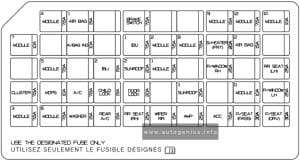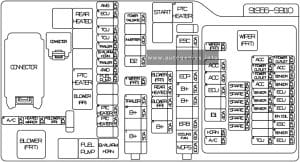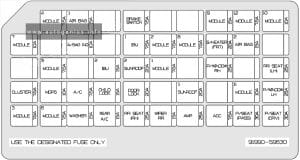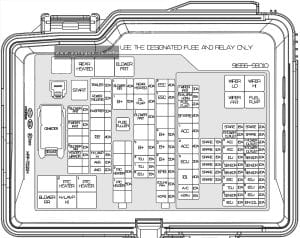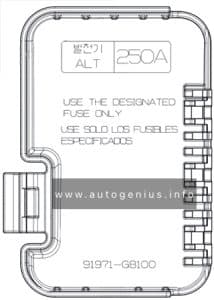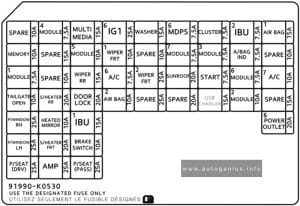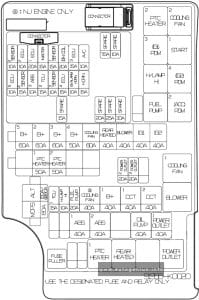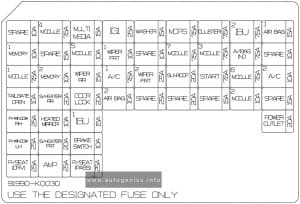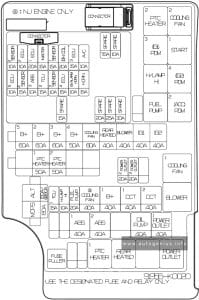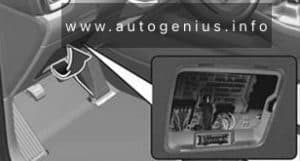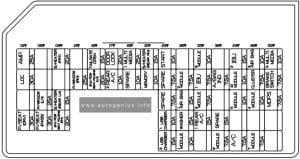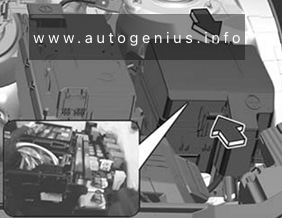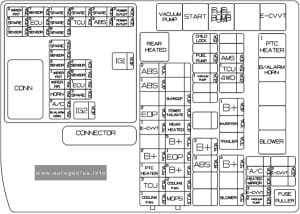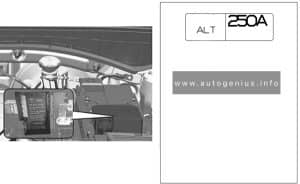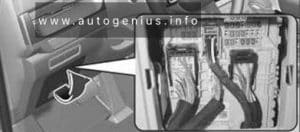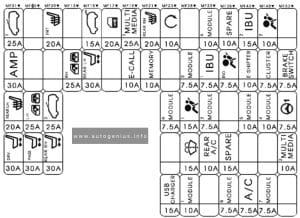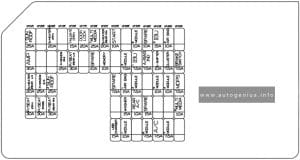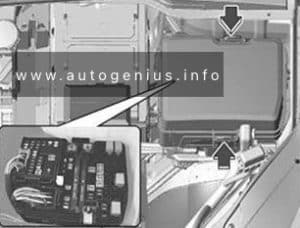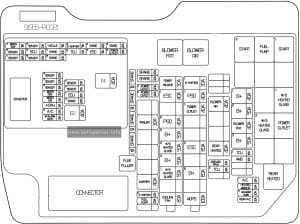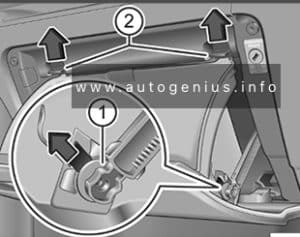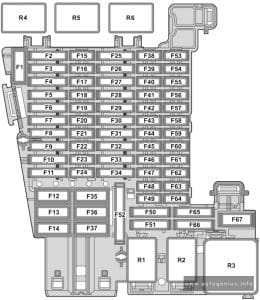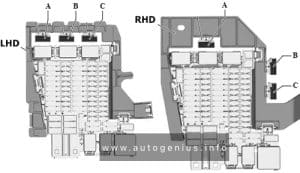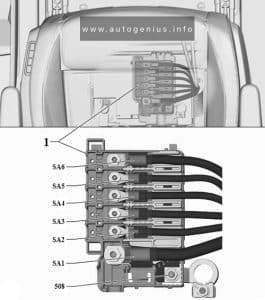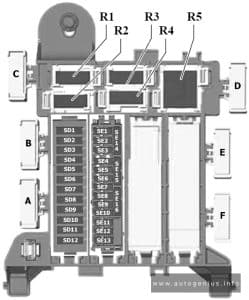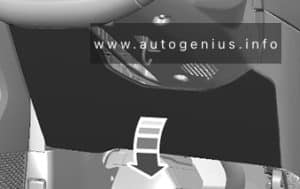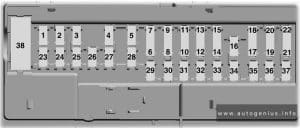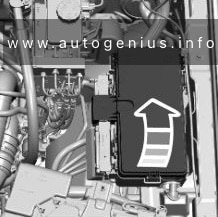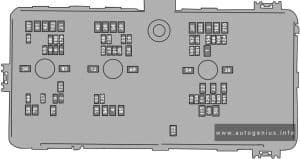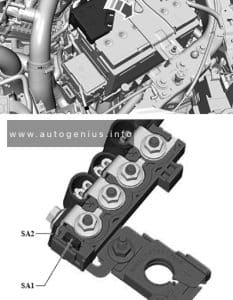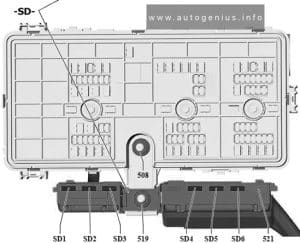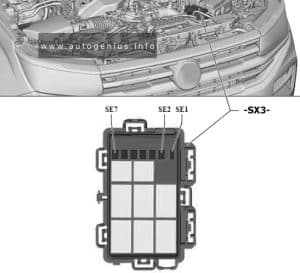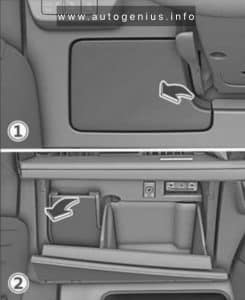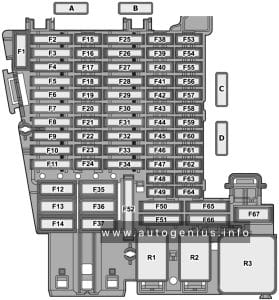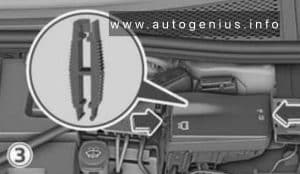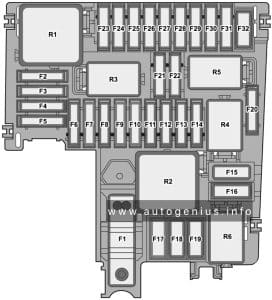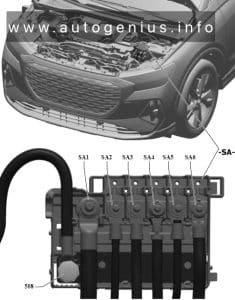KIA EV6 (2022 – 2024) – fuse and relay box diagram
Year of production: 2022, 2023, 2024
The Kia Telluride, a midsize SUV, has been available since 2020. This article provides fuse box diagrams for the 2023 and 2024 models, along with details on the locations of the fuse panels inside the vehicle and the functions of each fuse and relay.
Passenger Compartment Fuse Box
Fuse Box Location
The fuses are located behind the cover on the driver’s side.
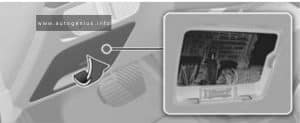
Fuse Box Diagram
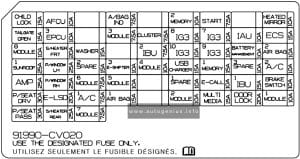
Assignment of the fuses in the Instrument panel
| Name | Amps | Circuit Protected |
|---|---|---|
| CHILD LOCK | 15A | Child Lock Relay, Child Unlock Relay |
| AFCU | 20A | AFCU |
| A/BAG IND | 7.5A | Overhead Console |
| MEMORY2 | 10A | ADP, Head-Up Display, ADS Unit |
| START | 7.5A | VCU, IBU |
| TAILGATE OPEN | 15A | Liftgate Latch |
| EPCU 3 | 10A | Rear Inverter |
| MODULE3 | 7.5A | Multifunction Switch, IBU, Stop Lamp Switch, Driver Door Module |
| CLUSTER | 7.5A | Head-Up Display, Instrument Cluster |
| IG3 8 | 10A | V2L Unit, ICCU, VCMS, SCU, Rear Electronic Oil Pump, CDM |
| IG3 7 | 10A | In-car Temperature Sensor, A/V & Navigation Head Unit, A/C PTC Heater, A/C Control Module, Instrument Cluster, Charger Indicator |
| IAU | 10A | Driver/Passenger Door Outside Handle |
| ECS | 15A | Not Used |
| MODULE8 | 10A | Driver/Passenger Power Seat Module, Driver/Passenger Manual Seat Switch |
| S/HEATER FRT | 20A | Front Air Ventilation Seat Control Module, Front Seat Warmer Control Module |
| WASHER | 15A | Multifunction Switch |
| IBU2 | 7.5A | IBU |
| IG3 10 | 10A | Rear Inverter, BMU |
| IG3 9 | 10A | Not Used |
| BATTERY MANAGEMENT | 10A | BMU |
| AIR BAG2 | 10A | SRS Control Module |
| SUN ROOF1 | 25A | Sunroof Control Unit (Glass/Roller) |
| P/WINDOW LH | 25A | Driver Safety Power Window Module, Rear Power Window Switch LH |
| SPARE2 (IG2) | 15A | Not Used |
| E-SHIFTER3 | 10A | Electronic ATM Shift Dial |
| MODULE4 | 10A | Front/Rear Corner Radar LH/RH, Front/Rear Inverter, ADAS Unit (Driving), VESS Unit, Smart Cruise Control Radar, Front View Camera (ADAS), ADAS Unit, Console Upper Cover Switch |
| USB CHARGER | 15A | Driver/Passenger Seat USB Charger, Front USB Charging Connector, Universal Island UBS Charger Connector |
| MEMORY1 | 15A | ICU Junction Block (Fuse Memory2), Instrument Cluster, A/C Control Module, Console Mood Lamp (Upper/Lower), Console Floor Switch, Driver/Passenger Door Mood Lamp, Rear Door Mood Lamp LH/RH, Instrument Cluster, Crash Pad Mood Lamp LH/RH, Mood Lamp Unit |
| SPARE3 (B+) | 10A | Not Used |
| A/C2 | 10A | A/C Control Module, High Pressure Valve, Refrigerants Valve #1/#2, P/R Junction Block (Blower Relay), BSA Chiller #1, A/C Coolant Valve |
| AMP | 25A | AMP |
| P/WINDOW RH | 25A | Passenger Safety Power Window Module, Rear Power Window Switch RH |
| MODULE6 | 7.5A | IBU |
| MODULE5 | 10A | Data Link Connector, Electro Chromic Mirror, ADP, A/V & Navigation Head Unit, Crash Pad Switch, AMP, Front Air Ventilation Seat Control Module, Front Seat Warmer Control Module, Smart Phone Wireless Charger, Driver/Passenger Power Seat Module, Rear Seat Warmer Control Module, Console Floor Switch |
| SPARE1 (ACC) | 10A | Not Used |
| E-CALL | 10A | Not Used |
| IBU1 | 15A | IBU |
| BRAKE SWITCH | 10A | Stop Lamp Switch, IBU |
| P/SEAT DRV | 30A | Driver Power Seat Switch, Driver Power Seat Module (With IMS) |
| E-LSD | 20A | Not Used |
| A/C1 | 7.5A | A/C Control Module |
| AIR BAG1 | 15A | SRS Control Module |
| MODULE2 | 10A | AMP, ADP, P/E Junction Block (Power Outlet Relay), IBU, ADAS Unit, A/V & Navigation Keyboard, A/V & Navigation Head Unit |
| MULTIMEDIA | 15A | A/V & Navigation Head Unit |
| DOOR LOCK | 20A | Door Lock Relay, Door Unlock Relay, Two Turn Unlock Relay |
| MODULE1 | 10A | Hazard Lamp Switch, Multifunction Switch, Data Link Connector, Rain Sensor, Puddle Lamp, PTG Unit, Driver Door Module, Driver/Passenger Outside Mirror Unit |
| P/SEAT PASS | 30A | Passenger Power Seat Switch, Passenger Power Seat Module |
| S/HEATER REAER | 25A | Rear Seat Warmer Control Module |
| MODULE7 | 7.5A | Not Used |
| HEATED MIRROR | 10A | Outside Mirror |
Engine Compartment Fuse Box
Fuse Box Location
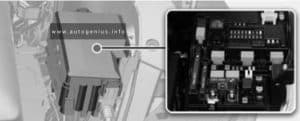
Fuse Box Diagram
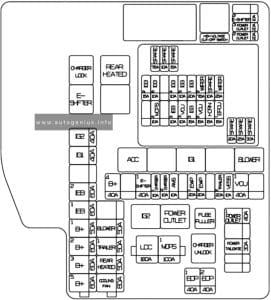
Assignment of the fuses in the engine compartment
| Name | Amps | Circuit Protected |
|---|---|---|
| LDC | 180A | P/R Junction Block (Fuse: POWER TAILGATE, EOP1, EOP2, POWER OUTLET1) |
| MDPS1 | 100A | EPS Unit |
| B+5 | 60A | PCB Block (IG3 Main Relay, Fuse: EPCU1, VCU2, WIPER1, HORN) |
| B+3 | 60A | ICU Junction Block (Fuse: EPCU3, P/SEAT DRV, P/SEAT PASS, P/WINDOW LH, P/WINDOW RH, AFCU, E-LSD, SUNROOF1, S/HEATER FRT, S/HEATER RR, AMP, MODULE8, TAILGATE OPEN, CHILD LOCK) |
| B+2 | 60A | ICU Junction Block (IPS1, PS6, IPS8, IPS9, IPS10) |
| B+1 | 50A | ICU Junction Block (IPS2, IPS3, IPS5, IPS7, IPS13) |
| IEB1 | 60A | IEB Unit |
| IEB2 | 60A | IEB Unit |
| IG1 | 40A | P/R Junction Block (ACC Relay, IG1 Relay) |
| IG2 | 40A | P/R Junction Block (IG2 Relay) |
| COOLING FAN | 80A | Cooling Fan Motor |
| REAR HEATED | 50A | P/R Junction Block (Rear Heated Relay) |
| TRAILER1 | 50A | Trailer Connector Unit |
| BLOWER | 50A | P/R Junction Block (Blower Relay) |
| B+4 | 40A | ICU Junction Block (Long Term Load Latch Relay, Fuse: IBU1, BRAKE SWITCH, AIR BAG2, A/C2, ECS, BATTERY MANAGEMENT, MODULE1, IAU, SPARE3(B+)) |
| E-SHIFTER1 | 40A | P/R Junction Block (E-Shifter Relay, Fuse: E-SHIFTER2) |
| CHARGER1 | 10A | P/R Junction Block (Charger Lock/Unlock Relay), ICCU, VCMS |
| CHARGER2 | 10A | CDM |
| AMS | 10A | 12V Battery Sensor |
| EWP1 | 20A | Electronic Water Pump #1 |
| EWP2 | 20A | Electronic Water Pump #2 |
| TRAILER2 | 20A | Not Used |
| VESS | 10A | VESS Unit |
| VCU1 | 40A | VCU |
| POWER OUTLET1 | 40A | P/R Junction Block (Power Outlet Relay) |
| POWER TAILGATE | 30A | PTG Unit |
| EOP1 | 40A | Rear Electronic Oil Pump |
| EOP2 | 40A | Front Electronic Oil Pump (AWD) |
| E-SHIFTER2 | 10A | P/R Junction Block (E-Shifter Relay), SCU, Electronic ATM Shift Dial |
| POWER OUTLET3 | 20A | Rear Power Outlet |
| POWER OUTLET2 | 20A | Front Power Outlet |
| WIPER1 | 25A | PCB Block (Wiper Main Relay) |
| EPCU1 | 15A | Front Inverter (AWD) |
| SPARE | 10A | Spare |
| HORN | 15A | PCB Block (Horn Relay) |
| WIPER2 | 7.5A | IBU |
| VCU2 | 15A | VCU |
| IG3 1 | 20A | ICU Junction Block (Fuse: IG3 7, IG3 8, IG3 9, IG310) |
| IG3 3 | 15A | Electronic Water Pump |
| IG3 5 | 10A | BMS Coolant 3Way Valve |
| VCU3 | 10A | VCU |
| IG3 4 | 10A | Front Inverter (AWD), Electronic Water Pump #1, #2, Electronic A/C Compressor |
| IEB3 | 10A | IEB Unit |
| IG3 6 | 10A | Cooling Fan Motor, Front Electronic Oil Pump (AWD) |
| MDPS2 | 10A | EPS Unit |
| IG3 2 | 15A | VCU |
| Relays | ||
| RLY.1 | CHARGER LOCK | |
| RLY.2 | E-SHIFTER | |
| RLY.3 | REAR HEATED | |
| RLY.5 | ACC | |
| RLY.7 | IG1 | |
| RLY.9 | BLOWER | |
| RLY.10 | IG2 | |
| RLY.11 | POWER OUTLET | |
| RLY.12 | CHARGER UNLOCK |
WARNING: Terminal and harness assignments for individual connectors will vary depending on vehicle equipment level, model, and market

